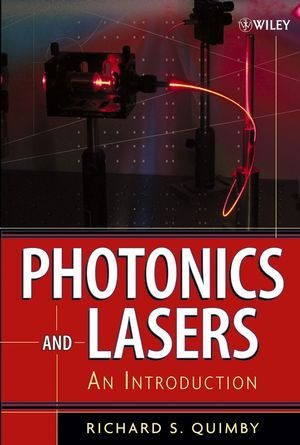|
Textbook
Photonics and Lasers: An IntroductionISBN: 978-0-471-71974-8
Hardcover
536 pages
April 2006, ©2006
 This is a Print-on-Demand title. It will be printed specifically to fill your order. Please allow an additional 10-15 days delivery time. The book is not returnable.
|
||||||
PART I: PROPAGATION OF LIGHT.
1. Overview.
1-1 Photonics Defined.
1-2 Fiber Optic Communications.
1-3 Overview of Topics.
2. Review of Optics.
2-1 The Nature of Light.
2-2 Light at a Boundary.
2-3 Light Passing through.
2-4 Imaging Optics.
3. Planar Waveguides.
3-1 Waveguide Modes.
3-2 Mode Chart.
3-3 Dispersion.
4. Cylindrical Waveguides.
4-1 Acceptance Angle and Numerical Aperture.
4-2 Cylindrical Waveguide.
5. Losses in Optical Fibers.
5-1 Absorption Loss.
5-2 Scattering.
5-3 Bending Losses.
6. Dispersion in Optical Fibers.
6-1 Graded Index Fiber.
6-2 Intramodal Dispersion.
7. Fiber Connections and Diagnostics.
7-1 Fiber Connections.
7-2 Losses in Fiber Connections.
7-3 Fiber Loss Diagnostics.
8. Photonic Crystal Optics.
8-1 1-D Photonic Crystals.
8-2 2-D Photonic Crystals.
8-3 3-D Photonic Crystals.
9. Nonlinear Optics.
9-1 Fundamental Mechanisms.
9-2 Frequency Conversion.
9-3 Nonlinear Refractive Index.
9-4 Electro-optic Effects.
PART II: GENERATION AND DETECTTION OF LIGHT.
10. Review of Semiconductor Physics.
10-1 Uniform Semiconductors.
10-2 Layered Semiconductors.
11. Light Sources.
11-1 The LED.
11-2 The Laser Diode.
12. Light Source to Waveguide Coupling Efficiency.
12-1 Point Source.
12-2 Lambertian Source.
12-3 Laser Source.
13. Optical Detectors.
13-1 Thermal Detectors.
13-2 Photon Detectors.
13-3 Noise in Photon Detectors.
Part 2 Generation and Detection of Light.
14. Photodiode Detectors .
14-1 Biasing the Photodiode.
14-2 Output Saturation.
14-3 Response Time.
14-4 Types of Photodiodes.
14-5 Signal-to-Noise Ratio.
14-6 Detector Circuits.
PART 3: LASER LIGHT.
15. Lasers and Coherent Light.
15-1 Overview of Laser.
15-2 Optical Coherence.
16. Optical Resonators.
16-1 Mode Frequencies.
16-2 Mode Width.
16-3 Fabry-Perot Interferometer.
17. Gaussian Beam Optics.
17-1 Gaussian Beams in Free.
17-2 Gaussian Beams in a Laser.
17-3 Gaussian Beams Passing.
18. Stimulated Emission and Optical Gain.
18-1 Transition Rates.
18-2 Optical Gain.
19. Optical Amplifiers.
19-1 Gain Coefficient.
19-2 Total Gain of Amplifier.
20. Laser Oscillation.
20-1 Threshold Condition.
20-2 Above Lasing Threshold.
21. CW Laser Characteristics.
21-1 Mode Spectrum of Laser.
21-2 Controlling the Laser.
22. Pulsed Lasers.
22-1 Uncontrolled Pulsing.
22-2 Pulsed Pump.
22-3 Theory of Q-Switching.
22-4 Methods of Q-Switching.
22-5 Theory of Mode Locking.
22-6 Methods of Mode Locking.
23 Survey of Laser Types.
PART 4: LIGHT-BASED COMMUNICATIONS.
23-1 Optically Pumped Lasers.
23-2 Electrically Pumped Lasers.
24 Optical Communications.
24-1 Fiber Optic CommunicationsSystems.
24-2 Signal Multiplexing.
24-3 Power Budget in Fiber Optic.
24-4 Optical Amplifiers.
24-5 Free-Space Optics.
Bibliography.
Appendix A: Solid Angle and the Brightness Theorem.
Appendix B: Fourier Synthesis and the Uncertainty Relation.
List of Symbols.
Index.



